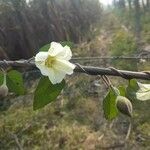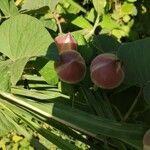Herbs perennial. Roots fleshy, long, much branched. Stems reddish, to 4 m, narrowly 3-5-winged, ± angular, gla-brous or densely pilose-tomentose on young parts. Petiole 2-10 cm, often winged; leaf blade cordate-circular, ovate, broadly ovate, ovate-lanceolate, or lanceolate, 4-14 X 3.5-14 cm, abaxially pubescent, adaxially appressed pilose to gla-brous, base cordate, truncate or obtuse, margin entire or undulate, apex acute or acuminate, mucronulate. Inflorescences cymose, often 2-flowered; peduncles 0.5-3 cm, usually terete; bracts 2, oblong to ovate-oblong, 1-2.5 cm, concave, pubescent. Pedicel 1.5-2 cm, striate-angular, clavate, to 4 cm in fruit. Sepals ovate to broadly ovate, unequal; outer 2 sepals 1.5-2 cm, abaxially pubescent; inner 3 shorter, subglabrous. Corolla white, sometimes with a yellowish base inside, broadly funnelform, 3.5-4 cm, glabrous, minutely yellowish glandular outside; limb 5-lobed. Filaments pubescent basally; anthers twisted. Fruit enclosed in cupular calyx, depressed globose, ca. 1.5 cm in diam. Seeds dull black, ovoid-trigonous, ca. 6 mm, glabrous. Fl. and fr. year round. 2n = 30.
Perennial twiner; stems narrowly 3–5-winged, angular or grooved, glabrous or shortly pilose, often rooting in water; young parts sometimes tomentose.. Leaf-blade very variable, orbicular to lanceolate, 5.5–15 cm. long, 1–14 cm. wide, acuminate to obtuse at the apex, mucronulate, cordate, hastate or truncate at the base, entire or rarely lobed or dentate, glabrous to velvety; petiole 2.5–7.5 cm. long.. Inflorescences 1–few-flowered; peduncle 2–18 cm. long; pedicels 1.2–3.5 cm. long, enlarging to 4 cm. in fruit and becoming clavate; bracts large, oblong or elliptic, 1.5–2 cm. long, 0.6–1 cm. wide, caducous.. Sepals ovate, acute or acuminate; outer 1.5–2.5 cm. long, 1 cm. wide, pubescent; inner about 2 cm. long, glabrescent; calyx accrescent in fruit, up to 6 cm. in diameter (lobes 3 × 2.5 cm.).. Corolla white, pinkish or yellowish, broadly funnel-shaped, 3–4.5 cm. long.. Capsule 1.5 cm. in diameter.. Seeds black, glabrous, 6 mm. in diameter.. Fig. 15, p. 62.
A herb. It is a climbing plant that keeps growing from year to year. The annual stems can be 2-4 m long. The stems have 3-5 narrow wings. The rootstock is fleshy and branched. The leaves are round or heart shaped and 4-14 cm long by 4-14 cm wide. They are hairy underneath. There are often 2 flowers together. They are funnel shaped and white but sometimes with yellow base.
Inflorescences cymosely 1-few flowered; peducle 2–10 cm. long terete or sometimes winged like the stems, glabrous or pubescent, pedicels up to 3 cm. long, enlarging in fruit and becoming clavate, bracts large, oblong or elliptic 1·5–2·5 × 0–5·1 cm., caducous.
Sepals ovate or broadly ovate, acute or acuminate, outer ones up to 2·5 × 1 cm., pubescent, inner ones about 2 cm. long, glabrescent, all accrescent in fruit, the calyx becoming broadly cupshaped, up to 6 cm. in diam.
Leaf lamina very variable in shape, circular to lanceolate, 4–10 × 1–9 cm., acuminate to obtuse at the apex, mucronulate, cordate, glabrous to velvety; petiole up to 5 cm. long, terete or sometimes winged.
Stems slender, narrowly 3–5 winged, angular or grooved, glabrous or shortly pilose, often rooting in water; young parts sometimes more or less tomentose.
Capsule depressed-globose about 1·5 cm. in diam., with circumscissile epicarp, the upper part of which comes off as an operculum or lid.
Corolla white, pinkish or yellowish, broadly funnel-shaped, 3–4·5 cm. long.
Perennial twiner with long much branched roots.
Seeds 4 or fewer, black, glabrous.



